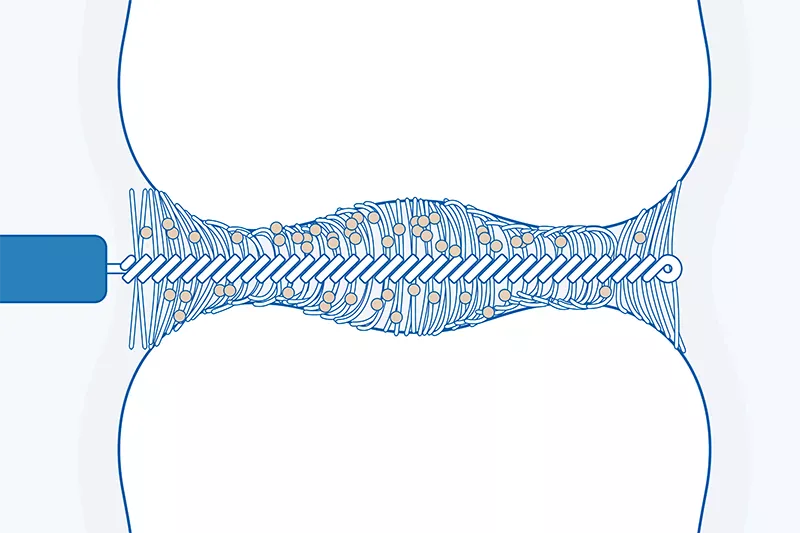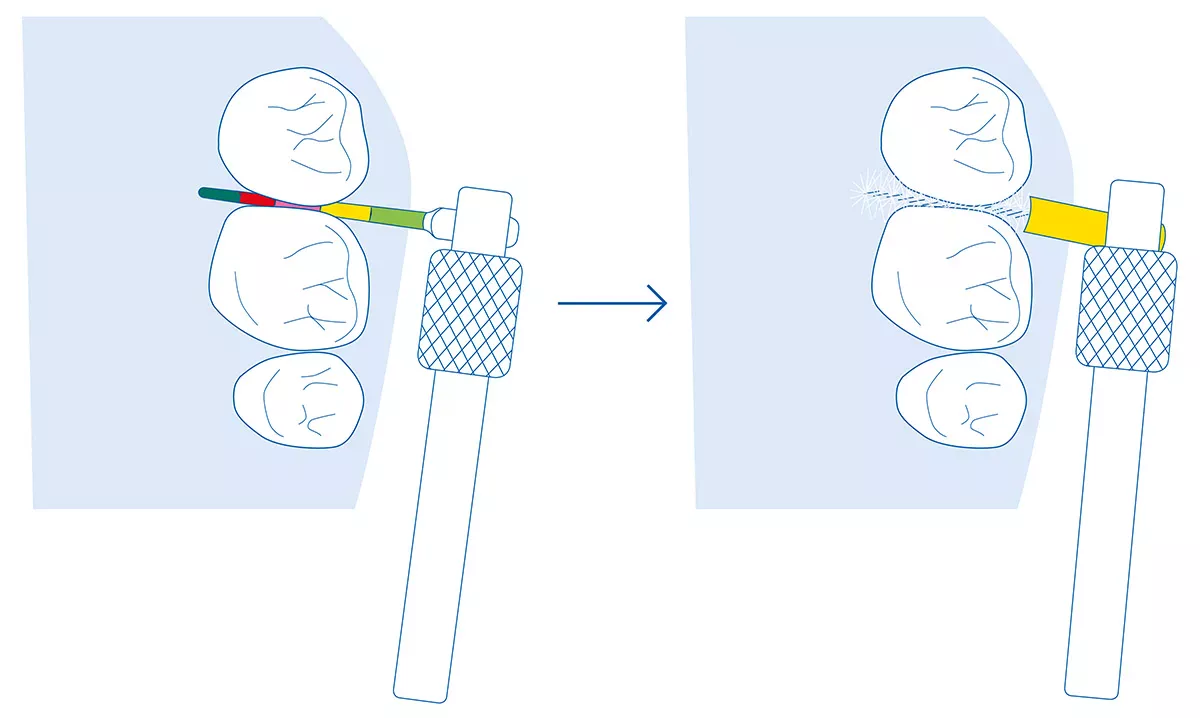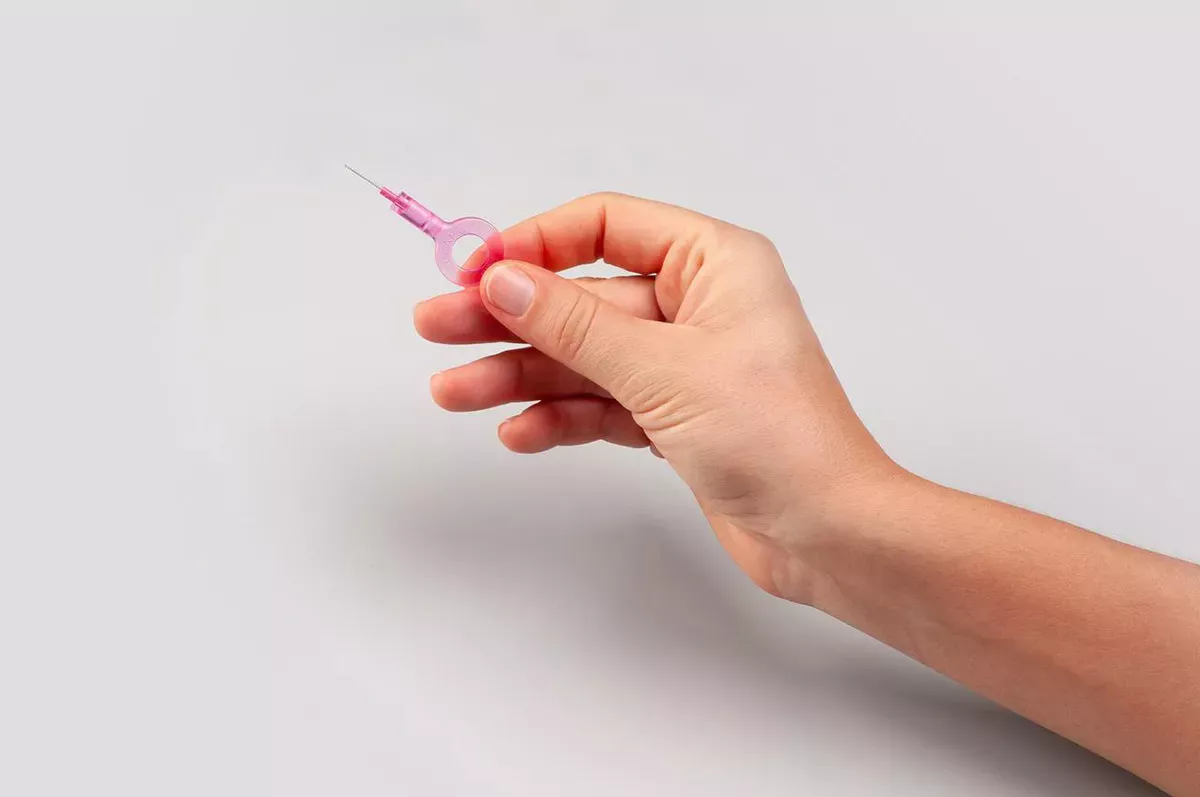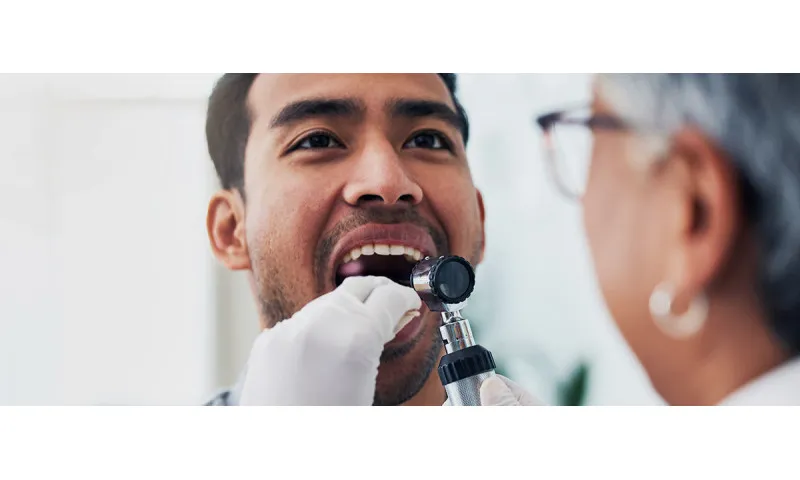Cleaning interdental spaces: Why is it so important?
Roughly 30 percent of the surfaces of your teeth are actually hidden between your teeth. But well hidden does not mean: Clean. Why should you clean these interdental spaces regularly? We have summarised the reasons for you below.
Preventing dental caries
The spaces between your teeth are usually quite narrow. Adjacent teeth come into contact with each other, creating spaces where tiny food particles can become trapped – often without us even noticing. If you fail to clean the interdental spaces correctly, these particles remain stuck in between your teeth and can turn into plaque. This, in turn, triggers a cataclysmic chain reaction: As over time, plaque develops into dental decay.
Protection against tartar
If not removed, plaque hardens into a substance known as tartar. The removal of hardened tartar is only possible during a professional dental cleaning session. If tartar is not effectively removed, it can contribute to the development of dental decay and gum disease. Interdental spaces are also susceptible to tartar. Yet another reason to clean the spaces between your teeth correctly. If your interdental spaces initially exhibit a yellowish tint, there is a good chance of being able to remove the still soft plaque using an interdental brush before it turns into tartar.
Interdental spaces can smell: Stop bad breath in its tracks
Bad breath is usually the result of poor oral hygiene. In this case, the malodour is caused by oral bacteria that have not been eliminated through correct brushing. These bacteria break down food debris into foul smelling substances. If we brush our teeth but fail to clean the interdental spaces correctly, bacteria can spread rapidly and cause a malodour.
This can also leave your interdental brush smelling pretty awful after use. But this is actually a good sign, as it means you have used it properly, removing malodorous dental plaque and food debris from the spaces between your teeth! The more often and the more steadily you use an interdental brush, the less it will smell.
Talking of a bad smell: If you suffer from bad breath and are still searching for its cause, start paying a little more attention to the hidden spaces between your teeth. If you have neglected these gaps over the years, they might even appear dark and discoloured.
If your interdental spaces are a darkish colour, it is high time to start cleaning them correctly. The first thing you should do is to have your dentist check that you do not have any dental decay. If your bad breath is severe and persistent, despite adopting a strict oral hygiene routine, you should always consult a health care professional.
Removing the coating and bacteria on your tongue is also an effective approach to getting rid of your bad breath successfully. And the best way to do it is with a tongue scraper.
Interdental brushes – the best tool for cleaning interdental spaces
A study in the European Journal Of Oral Sciences and other reputable studies have shown that: Interdental brushes are the most effective way to clean interdental spaces correctly. Discover everything the small brushes can do here.
What is an interdental brush?
Interdental brushes are a complementary tool for your oral hygiene routine. They usually consist of a small holder and a fine brush. These brushes effectively access and clean even the narrowest of interdental spaces.
Seeing as the gaps between your teeth can vary greatly, we recommend having your interdental spaces measured by a dentist to determine their exact sizes. You can then use this information to select the ideal interdental brushes for your teeth.
Curaprox offers calibrated interdental brushes, i.e. brushes perfectly tailored to your interdental spaces. All it then takes is a swift back and forth brushing motion to clean the spaces between your teeth. This is due to the ultra-fine bristles that are attached to a patented surgical wire. They ensure an "umbrella effect".
This means: The fine individual bristles are designed to compress as you slide the interdental brush through the tight gaps between your teeth, before opening up after entering the larger interdental space. This ensures the gentle and effective removal of dental plaque and food debris.
Good to know:
Are you already using an interdental brush and want to know how often you should incorporate it into your oral hygiene routine? We recommend using it at least once a day – preferably at night before going to bed. But there is no harm in using it twice a day if you want.
Interdental brush or dental floss? Why interdental brushes are better
Interdental spaces need to be cleaned regularly. Studies have shown that the best cleaning effect is achieved using interdental brushes. However, they should always be used in addition to toothbrushing as part of your daily routine. This combination helps achieve and maintain the best possible oral hygiene.
But what makes interdental brushes more recommendable than dental floss, for example? The simple reason for this is that you have a much better chance of removing stubborn dental plaque or food debris with a brush than with a thin, soft thread. The thread is much smoother and tends to glide over sticky bacterial film instead of scraping it off.
Despite being small, thin and delicate, dental floss is not exactly easy to manoeuvre. It often fails to bend and contour to the shape of your teeth. Brushes, in contrast, are very good at this.
Yet another advantage of interdental brushes: They are much easier to use than dental floss. While the long thread, wrapped awkwardly around your fingers, can often be a source of frustration and annoyance, interdental brushes come with a practical holder that ensures superior control when brushing.
Moreover, there is less chance of harming your mouth with interdental brushes. They are more comfortable and softer on your teeth and gums, thereby allowing for better cleaning and more control. Dental floss, in contrast, often "snaps" uncontrolled into your gums and you always have to be gentle to avoid any excess damage.
Good to know:
Interdental brushes are highly efficient without the need for any hard bristles. Quite the contrary: They have to be soft to prevent damaging your teeth and irritating your gums. Our interdental brushes are equipped with ultra-fine bristles – tiny individual hairs – that are soft, efficient and boast rounded tips.
Interdental brushes to prevent gum disease
Chronic gum disease, or gingivitis, is the leading cause of tooth loss and, in its most severe form, ranks as the sixth most prevalent ailment worldwide. Reason enough to protect yourself effectively against it. And interdental brushes play a key role in ensuring complete dental hygiene. When used on a daily basis, they help keep your teeth and gums healthy – and also support regeneration should you already be suffering from gum disease.
In these cases, we recommend using the Curaprox interdental brush CPS 410. It is ideal for severely inflamed gums and can also help to stop gum disease before it even starts in larger interdental spaces.
Interdental brush: Which size is the right one?
Interdental brushes clean the spaces between your teeth highly effectively – but only if you use the right size. The brushes are available in a range of sizes, which makes them perfect for every interdental space. Since interdental spaces, which, by the way, can get bigger with age, can vary greatly between teeth in the same mouth.
Using an interdental brush that is too small may not effectively remove dental plaque and food debris as it fails to fill the whole interdental space. We therefore do not advise you to just grab any old brush, hoping that it will fit.
But how do you find out which size is the right one to clean your interdental spaces effectively? Ideally, you have your teeth cleaned professionally at regular intervals. So, if you are unsure about which brushes to use, simply ask during your next appointment. It is customary for your dental hygienist to also employ interdental brushes as part of the procedure. They can tell you how big the spaces between your teeth are and which brushes are the right ones for you.
Needless to say, you can also ask your dentist for advice. They can measure the interdental spaces professionally – for example with the Curaprox IAP Prime probe.
The Curaprox Prime Start mixed set is a great way to check out and test various brushes at home: The set includes a comprehensive range of sizes, allowing you to experiment and determine which one is best for your interdental spaces. Note that the brush should fit snugly and be in slight contact with the sides of your teeth or gums, while exerting sufficient pressure.
Good to know:
It is safe to say that the spaces between your teeth vary in size. One reason for this could be that you are already suffering from early-stage periodontitis. This leads to gum recession, resulting in larger interdental spaces. Furthermore, our teeth are not straight and evenly spaced from the start. It is important to take this into account when purchasing interdental brushes. You most probably need a whole range of sizes. The best way to find out is to ask the next time you have a dental appointment.
Are there alternatives to interdental brushes?
There are lots of tools on the market to help keep your interdental spaces clean. But studies have shown the effectiveness and benefits of using interdental brushes.
We have summarised some of the other options available – besides the aforesaid dental floss – and the advantages and disadvantages they each have:
Cleaning with an electric water flosser
You can clean your interdental spaces with a water flosser, also known as an oral irrigator. These oral care instruments can be used at home. Simply aim the water jet into the spaces between your teeth to dislodge and flush out any food debris and dental plaque – ideally! Since a water flosser is quite easy to use but is not the optimal choice for removing more stubborn plaque.
There is no way of ensuring that all the plaque between your interdental spaces is removed fully with a water flosser. In fact, interdental brushes, which can get rid of food debris and dental plaque in between your teeth with gentle pressure and reach into every nook and cranny of your interdental spaces, are much more effective.
Yet another disadvantage of a water flosser: Under certain circumstances, individuals with heart defects and artificial heart valves face potential risks. They are susceptible to inflammation of the inside lining of the heart chambers and heart valves (endocarditis). The pathogens responsible for this disease can be forced from the oral cavity into the bloodstream, leading to the aforementioned inflammation.
Ultrasonic dental cleaning
Ultrasonic dental cleaning is a procedure typically performed in a dental practice. It effectively eliminates bacterial plaque and tartar from all surfaces within your mouth, including any brown spots and discolouration in between your teeth.
An ultrasonic tooth cleaner or scaler consists of a handpiece and a curved metal tip.
In an ultrasonic cleaning instrument, the electric power is transformed into vibrational energy. This technique effectively blasts plaque from the surface of the teeth. Ultrasonic cleaning is gentle and painless.
Various ultrasonic tooth cleaners are also available for home use and promise to clean your teeth thoroughly – even removing tartar.
However, a measure of caution is called for here: As a rule, these inexpensive instruments do not come anywhere near the quality provided by professional ultrasonic cleaning services at a dental practice. Some of them do little else than vibrate. Further, you should note that using an electrical instrument of this nature is risky and can cause harm.
It really is better to clean interdental spaces with interdental brushes and to have your teeth cleaned regularly by a dental hygienist.
How to clean interdental spaces: Instructions
Using interdental brushes could not be easier. But before you get started, there are a few things you should know. We have summarised the key points in the instructions below:
Choose the right size
As already described, the first step is to choose the right interdental brushes for the spaces between your teeth. Simply ask your dentist or dental hygienist during your next professional teeth cleaning session.
Find a comfortable position for cleaning
Do not worry: Most people intuitively hold interdental brushes correctly. But if you are still uncertain, just think of how you would hold a pencil. And do the same with your interdental brush – holding it between your thumb and index finger.
Be careful during initial use
Always take enough time to do a thorough job of cleaning; especially if you do not have much practice with interdental brushes. Slide the brush gently between your teeth from the front. You do not need to exert a lot of force – once the interdental brush is through the gap, it is enough to simply pull it out again. There is no need to pull it back and forth lots of times.
Bleeding gums are quite normal at first
It is not uncommon for your gums to feel a bit sore and to bleed the first few times you clean your teeth with an interdental brush. In this case, it is highly likely that your gums are already inflamed. This usually occurs when we fail to clean our interdental spaces regularly.
The good news: As soon as you start using interdental brushes on a regular basis, the bleeding in the interdental spaces should start to reduce after three to seven days.
Rinse the brush quickly after cleaning each interdental space
We obviously want to prevent food debris being transferred from one interdental space to the next. As that would defeat the object of cleaning. So, remember to rinse your interdental brush with water after cleaning each space. This ensures that any food particles between your teeth end up in the sink and not back in your mouth. Finally, the best thing to do is to rinse your mouth with water.
Remember to brush your teeth
One question you might have asked yourself is whether you should use your interdental brush before or after brushing your teeth? Unfortunately, there is no clear-cut recommendation. Dental hygiene is a very individual matter. Whether you use your interdental brush before or after brushing your teeth depends on what your routine looks like on a typical day.
For instance, if you have cleaned your teeth thoroughly and effectively in the evening, you can use your interdental brush first in the morning. As you are not likely to unwittingly transfer food debris or dental plaque into your interdental spaces. If, on the other hand, you have been out and about all day without being able to clean your teeth, it is best to first brush your teeth thoroughly with a toothbrush before cleaning the interdental spaces with an interdental brush.
In our opinion: It matters more that you clean your interdental spaces regularly every day than when you actually do it. If you are still unsure about what time of the day is best, simply ask your dentist or dental hygienist during your next professional teeth cleaning session.
Are you still looking for the ideal piece of equipment for brushing your teeth? Find our whole range of toothbrushes here.
Good to know:
Besides being more effective, interdental brushes are more sustainable than dental floss. Since: You can usually use them many times before they need replacing. In this respect, they are similar to a normal toothbrush. The added bonus of our interdental brushes is that you only need to buy replacement brushes. You can use the same holder over and over again – and that means less waste.
The bristles of your interdental brush are usually a reliable indicator of when it needs to be replaced. When they start to "fray" or lose their strength, it is time for a change.
Interdental brushes: What is the best way to store them?
Interdental brushes are generally much smaller than toothbrushes – and are often kept gathering dust in drawers and boxes and on shelves in bathrooms. This is, however, not very advisable, as it not only makes them difficult to find but also exposes them to potential contamination. In the worst case, you will be putting dirt and germs back into your mouth.
It is, therefore, essential to store them as hygienically as possible. And this can be achieved, for example with the Curaprox CPS 457 pocket set. Your interdental brushes are thus tucked away safely when on the move, but also remain nice and clean when at home.
The Ortho pocket set also provides the perfect storage space for interdental brushes. This functional box includes interdental brushes that are also ideally suited for cleaning teeth fitted with fixed braces.
Interdental brushes – tips for pleasant use
The small interdental brushes are extremely easy to use. However, if you are unsure about their use, here are some tips and answers to make your daily dental hygiene routine even more pleasant and enjoyable.
Do your gums bleed? What you can do to prevent bleeding
As explained above, it is quite normal for gums to bleed a bit when you first use interdental brushes. And do not give up even if the bleeding does not resolve immediately. Your interdental spaces need to be cleaned thoroughly. And if you fail to do so, you may end up with your gums becoming more and more sensitive. You can also ask your dentist about the possible reasons for the bleeding. They will tell you about the best way to clean your interdental spaces thoroughly at home.
Very narrow interdental spaces? How to keep them clean
Interdental spaces can vary greatly between teeth in the same mouth. While your interdental brush is ideal for some of your spaces, it might be impossible to slide it through others. That is rarely the case though, as interdental brushes are also available in very small sizes.
The Prime Start set includes, for example, the smallest variant, which can be used to clean even the narrowest of interdental spaces.
Are even the smallest interdental brushes too big? To clean extremely tight contact points, you can always use dental floss as an alternative. Dental floss basically fits through every interdental space but is not as effective as interdental brushes when it comes to cleaning the gaps between your teeth.
If you require dental floss to clean between your teeth, we recommend using Curaprox DF 820 PTFE dental tape, which is perfect for getting into those tight spots.
Can interdental brushes be disinfected?
Going by the plethora of tips and tricks online, many people appear to have asked themselves the same thing. However, it is not something that we would recommend. No matter how much disinfectant you apply, you will never get your interdental brush completely germ-free and totally clean. It is better to save yourself the hassle and to replace the brush on a regular basis. This ensures you are on the safe side.
Summary
Cleaning your interdental spaces is just as important as brushing more readily accessible tooth surfaces. And just because you cannot see or reach them easily, does not mean that cavity-causing bacteria are not making themselves at home there. Quite the contrary: They love to colonise these areas of your oral cavity.
We recommend the use of interdental brushes to clean your interdental spaces thoroughly and effectively. Studies have shown that they are the best tool for removing dental plaque and food debris. That said, interdental brushes should never replace brushing your teeth correctly with a toothbrush. But together, they are an unbeatable combination.
If you are unsure about which size of interdental brush you should use, simply ask your dentist or dental hygienist during your next professional teeth cleaning session.
Sources:
Initiative Pro Dente: Zahnzwischenraum.
Praxis für Zahnmedizin, Zahnarzt Peter Schmidt: Warum das Reinigen der Zahnzwischenräume so wichtig ist.
MDS MANUAL: Mundgeruch, updated: February 2022.
MedLexi: Interdentalbürste, updated: 14 November 2021.
ÖKO-TEST Jahrbuch für 2023; Lisa-Marie Karl/Frank Schuster/Lena Wenzel Zahnzwischenraumbürsten-Test: Wie schlagen sich Te Pe, dm & Co.?, updated: 13 October 2022.
Ankerzahn e.V.: Interdentalbürste oder Zahnseide – Stiftung Warentest und die Zahnseiden-Lüge, updated: 5 May 2022.
Alldent Zahnzentrum: Parodontitis.
Zahnarztpraxis Dr. Robert Balan: Professionelle Zahnreinigung – Wellness für die Zähne.
Zahnzentrum Mitte: Was können Mundduschen?.
Prof. Dr. med. Dent. Imfeld, Thomas: Zahnseide zur Mundgesundheitsprophylaxe?.
Privatpraxis für Zahnheilkunde, Dr. Dimitrios Papavasileiou & Dr. Philipp Raab GbR: Wie funktioniert professionelle Ultraschall Zahnreinigung?.
BesserGesundLeben: Ultraschall-Zahnreinigung: Die Vor- und Nachteile, updated: 4 November 2022.
Dentalwissen: Ultraschall Zahnsteinentferner für Zuhause, updated: 13 March 2023.
PD Dr. Sahrmann, Philipp, Universitäres Zentrum für Zahnmedizin Basel: Übersichtsarbeit Risikofaktoren für die Zahngesundheit, updated: 1 September 2022
 Swiss premium oral care
Swiss premium oral care










